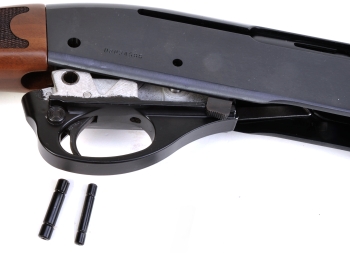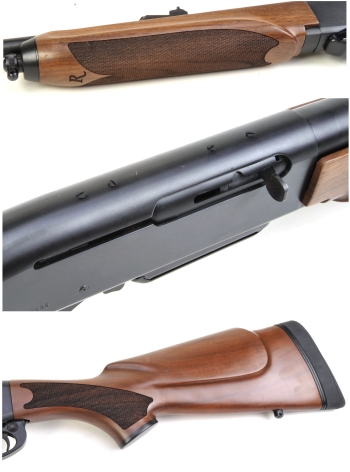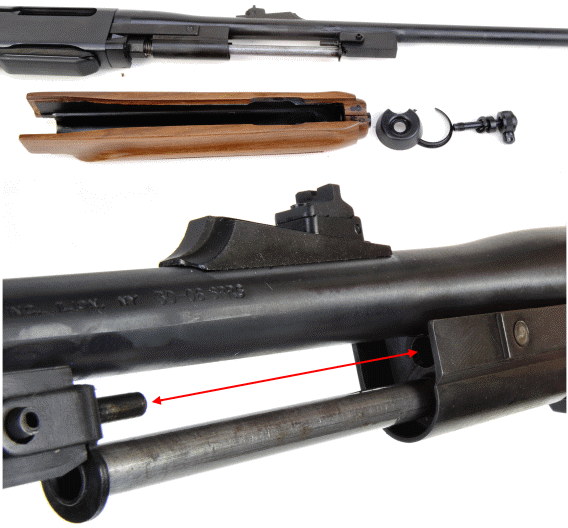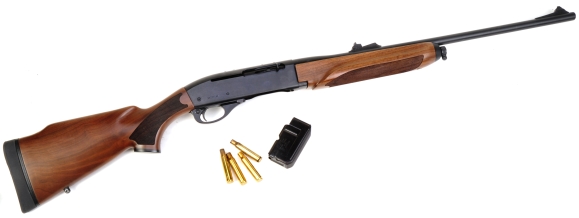I like Maine. Even with Spring not far off, it’s cold and wet, with patches of snow and promise of lots more in the weather forecast. This morning my wife and I poured our cups of wake up coffee and watched the resident flock of cranky turkeys successfully drive off a small herd of deer from a shared food supply. Then, with my wife waving goodbye, I headed out to the shop, slipped in a pile of fresh moose… signs and fell on my butt. Not pretty. Not at all. But apparently, at least to my wife, very funny.
This was a tough review to write. Not because of deficiencies in the gun, but rather because it is an interesting rifle in a number of respects, which made it difficult to assemble all of the information into a logical presentation. So please bear with me.
The Remington Model 750, pictured right, almost disappears into the Maine woods, as a good hunting rifle should. Satin black metal finish, satin walnut stock… If I were writing a catalogue narrative for a snooty firearms auction, I would describe the Model 750 as having a look of understated elegance. Perhaps something to be expected from a rifle model that has experienced over half a century of commercial evolution under the watchful eye of Remington. This may also be why a brand new Model 750 felt like a comfortable, well seasoned firearm, the moment I took it out of the box.
Lineage
In 1900, Remington purchased a patented design held by John Browning and used it a the basis for their 1906 Model 8 introduction. The event marked Remington’s first production of a centerfire autoloading rifle, however, it was recoil operated and its barrel was part of its considerable reciprocating mass. The forerunner of the Model 750, Remington’s first gas operated centerfire rifle, would not come along until 1955 in the form of the Model 740 Woodsmaster, with its then new Power-Matic operating system*. This change from recoil to gas operation was core to this design and allowed Remington’s autoloader to handle more powerful cartridges such as the: .30-06 Springfield, .308 Winchester, .270 Winchester, the .280 Remington, and .244 Remington. The Model 750, representing the latest evolution of this product line was introduced in 2006.
Does the Model 750 have GPS and All Wheel Drive?


| Manufacturer |
Remington |
| Model |
750 |
| Chamber |
.30-06 Springfield |
| Capacity |
4+1 |
| Stock |
Satin Finish – Walnut |
| Hardware |
Polished – Blue |
| Sights |
Metallic Adjustable |
| Action Type |
Autoloader – Gas |
| Barrel Length |
22″ |
| Twist |
1:9⅛” |
| Weight |
7.5 lbs |
| Trigger pull |
5 lbs 2 oz. |
| Overall Length |
42 5/8″ |
| Length of Pull |
13 1/2″ |
| Drop at Comb |
1 5/8″ |
| Drop at Heel |
2 1/2″ |
| MSRP |
$914 |
| Discount Retail |
$784 |
There are a number of optional chambers available for the Model 750: 243 Winchester, 270 Winchester, 30-06 Springfield, 308 Winchester, and the 35 Whelen. The last three are also available in carbine lengths with 18½” barrels.The Model 750, when chambered for the .30-06 Springfield with a 22″ barrel has a 1:9⅛” twist. In carbine length, 18½” barrel, the twist is 1:10″, the same as the .308 Winchester in either rifle or carbine versions. The Model 750 is available with a synthetic stock in rifle and carbine lengths, however, absent is the .35 Whelen chamber with this stock option at the time of this writing.
Initial Impressions
As noted earlier, the appearance of the gun is contemporary, an example of understated elegance. Clean lines, nicely figured walnut stock, satin finish walnut and satin polished blued hardware. This particular gun scaled 7 lbs 10 ounces, or within a wood density 2 ounce difference of specification.
The Model 750 feels balanced and steady in standing, kneeling, sitting, and prone shooting positions…which is more than I can say for myself. The wide forearm is hand filling, which makes for a good grip. The high comb, moderate cheekpiece provide good support at a height appropriate for both metallic and scope sighting. The pull length and SuperCell recoil pad are comfortable.
Most recent model refinements…
The Model 750 incorporates a number of functional improvements over the Model 7400, the Model 750’s immediate predecessor. The gas port on the Model 750 is drilled at a 45° angle, rather than the 90° angle of earlier models and moved aft. The change in angle of intersection minimized copper fouling at the port and the aft relocation placed the port in a consistently higher pressure area of the gun’s bore for enhanced cycling reliability. These changes not only improved overall performance of the series, they also permitted Remington to expand the range of cartridges offered in carbine length guns. Additional changes – The barrel extension that serves as the bolt lock up surface at the end of the barrel was changed from machined to cast for the sake of improved geometry and absence of tool marks. The bolt face received a nickel/Teflon coating to ease bolt closing and camming. Finally, the drop at the stock’s comb was increased to allow more natural eye/sight alignment.
A closer look…
Magazine loading is handy, reloading and for carrying different types of ammo in a coat pocket. Insertion and removal is positive, release is accomplished by depressing the tab just aft of the magazine well on the right side of the gun. Releasing the Remington Model 750’s bolt to battery position is accomplished by moving a sliding button that is integral to the left side of each magazine. The gun’s cross shaft safety is embedded in the aft portion of the trigger guard, indexed with a red ring on the left side to indicate when the safety is in the “fire” position. Again, a positive control. Opening the action with the operating handle requires a modest amount of effort, but slams shut with enough force to assure a round will be stripped from the magazine and fully chambered.
That’s a pretty unique forearm profile, but it feels good when shooting and it keeps the muzzle under steadying control. Excellent checkering pattern and nifty Remington monogram.
The top of the receiver is…anti snaggable, and tapped for scope mounts; most popular brands and types readily available. The metallic sight set is on the barrel, rather than split receiver/barrel, which is a good arrangement for accuracy in a gun of this type. For the scope shooting portion of the review I picked up a set of low profile Warne steel Weaver style bases to use with ring sets for both 1″ and 30mm tube scopes.
The buttstock is neatly checkered in an appropriate pattern, the grip is capped and, again, swivel studs and a quality recoil pad.
I’ve been spending a good deal of time lately with AR 15 and AR 10 type and derivative firearms. Hard to believe the Remington could have a very similar gas system, but look this good. Hmmm, with a thirty shot mag…
Cleaning and Maintenance…the fun stuff
Take down for maintenance is a straight forward proposition. After checking to ensure the firearm is empty, the bore is cleaned muzzle to chamber. No, I don’t mean every time you check the gun for empty you must follow with cleaning. I’m just saying, if you’re going to clean your gun, first make sure it is empty. Capice? The chamber is cleaned through the ejection port. Periodically, the action tube and spring and area under the forearm can be solvent sprayed and wiped down by removing the forearm. The front forend screw is removed and the forearm is pushed forward and off. The simplicity of the operating system can be seen above where the tube from the gas block, integral to the barrel, pumps gas pressure back to the breech bolt.
 Trigger assembly cleaning is easy. With the gun empty and trigger mechanism cocked, the two trigger mount pins are pushed out and a little downward tug on the trigger guard removed the entire assembly.
Trigger assembly cleaning is easy. With the gun empty and trigger mechanism cocked, the two trigger mount pins are pushed out and a little downward tug on the trigger guard removed the entire assembly.
This is the only area that could stand a little improvement. I believe I have gotten so spoiled by Remington’s X-Mark PRO Adjustable bolt gun triggers, I have the same expectation of quality and refinement in every Remington firearm I shoot. The Model 750 trigger isn’t bad, it just isn’t perfectly crisp, clean and adjustable as is the case with Remington guns fitted with the X-Mark PRO trigger.
How does it shoot? Commendably well.
The Remington Model 750 is probably the softest shooting .30-06 Springfield I’ve had the pleasure of shooting, pushing 150 – 220 grain factory and handloaded ammunition. It was very easy to get off a fast second shot while staying on target. I’m sure the SuperCell recoil pad had a lot to do with it, but I could also feel the dampening effect of the gas system. There was virtually no muzzle climb and the gun stayed in hold after each round.
The open sights are OK for those folks who like to shoot with metallic sights rather than a scope. The adjustments are precise, the sight picture is crisp, but I’d like something other than a white bead for a front sight in this type of climate and terrain. A good HiViz sight set up would be nice in brush country of the type we have here in Maine. I want to save the live fire results for the next installment as this proved to be interesting and little too much to squeeze into this space.
Remington’s Model 750 – Part I
Remington’s Model 750 – Part II






 Trigger assembly cleaning is easy. With the gun empty and trigger mechanism cocked, the two trigger mount pins are pushed out and a little downward tug on the trigger guard removed the entire assembly.
Trigger assembly cleaning is easy. With the gun empty and trigger mechanism cocked, the two trigger mount pins are pushed out and a little downward tug on the trigger guard removed the entire assembly.

Email Notification